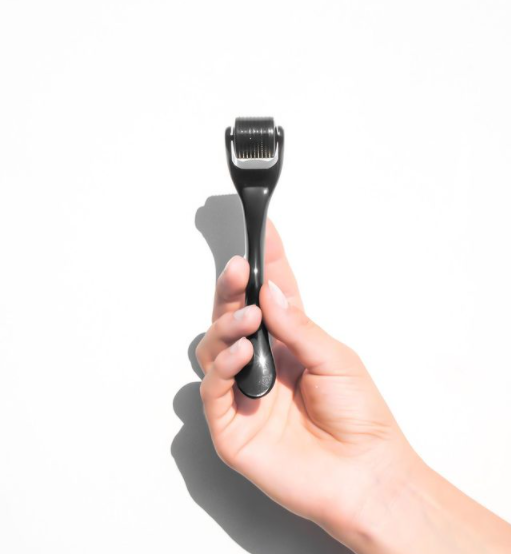
The quest for clear and glowing skin seems endless. There's always a new trend or product that promises an end to acne, dark spots, lines, or wrinkles. The options can be overwhelming and continue to grow in number every year. One of the newer skin care procedures is dermarolling. It's a process of using a handheld microneedling device that you roll across your face in different directions to make tiny incisions. This supposedly triggers collagen production to improve skin texture and help fade acne marks and other dark spots. It also helps skincare products to penetrate deeper. But is it safe?
Who can benefit from dermarolling?
According to celebrity facialist Candace Marino, when dermarolling is done correctly, the effects are wonderful. She explains that most skin types can benefit from it, but she advices avoidance for those who are prone to acne and inflammation. However, medical aesthetician Mashell Tabe tells Cosmopolitan that if you have just one or two active bumps, all you have to do is avoid those areas. If you're experiencing a massive breakout all over your face, it's best to try it once you've addressed that to prevent bacteria from spreading.
Also read: Beauty Insiders Agree That These Are The Most Talked-About Beauty Products of 2020
How do you choose a dermaroller?
Licensed aesthetician Tiffany Markarian tells Elle that the common size of a dermaroller is 0.25. This needle size is enough to make microchannels in the skin so your skincare products can penetrate deeply. She shares that the deeper the depth of the needle, the better it is to help improve scarring. Cosmopolitan recommends Ora Microneedle Face Roller System (0.25mm), Stacked Skincare Micro-roller (.2mm), Environ Gold Roll-CIT (.2mm), and Beauty Bioscience GloPRO Dermaroller (.3mm).
Markarian adds that using a dermaroller with a good-quality vitamin C serum will truly help with scarring issues. For those with rosacea, hydrating serums will work best.
The dermarolling process.
Cleanse your skin very thoroughly using a sulfate-free facial wash. Cosmopolitan's top picks are Neutrogena Ultra Gentle Hydrating Cleanser for normal skin, Garnier SkinActive Gentle Face Wash for oily skin, Vanicream Gentle Facial Cleanser for sensitive skin, and Dove DermaSeries Fragrance-Free Face Wash for dry skin.
After cleansing, use a hydrating toner. Allure suggests Mamonde Rose Water Toner, Dr. Jart+ Ceramidin Liquid Moisturizing Toner, or Fresh Rose Deep Hydration Facial Toner.
Apply your treatment serum. If acne scars are your main concern, go for brightening serums like Dr. Dennis Gross Skincare C+ Collagen Brighten + Firm Vitamin C Serum, SkinCeuticals Discoloration Defense, and Glow Recipe Pineapple-C Brightening Serum.
For the dermarolling process, do three separate passes over your skin - horizontal, vertical, and diagonal. Use mild to medium pressure, especially under the eyes and the lips. For bony areas like the forehead, cheekbones, and nose, use very light pressure to avoid prick marks.
Aftercare for demarolling.
Lisa Goodman, co-founder of Goodskin Clinic, advices against using glycolic, lactic, and salicylic acids right after dermarolling because they may cause irritation. Instead, you can try the more hydrating hyaluronic acid then use a thick moisturizer over it to help the skin recover from the procedure.
For best results, Goodman suggests changing your dermaroller head after three to six months as the needles will inevitably get dull. Make sure to rinse your dermaroller after each use. Use hot water to clean it, then sterilize it by dipping it into 75 percent isopropyl alcohol for five minutes.
Related article: These are the Most Common Skin Care Issues of Women Over 40
